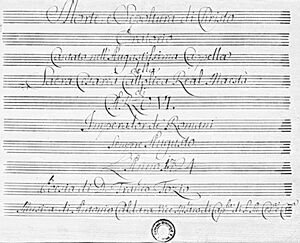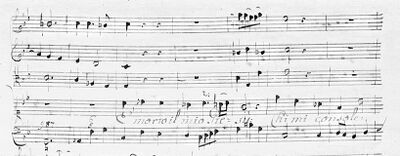Difference between revisions of "È morto il mio Gesù"
| Line 172: | Line 172: | ||
==Manuscripts and sheet music== | ==Manuscripts and sheet music== | ||
[[File:Incipit of | [[File:Incipit of E morto il mio Gesu.jpg|thumb|400px|alt=Incipit of "È morto il mio Gesù"|Incipit of "È morto il mio Gesù"]] | ||
<!-- incipit --> | |||
:Free Score at the IMSLP: | :Free Score at the IMSLP: | ||
:Copyist of Vienna | :Copyist of Vienna | ||
Revision as of 03:03, 15 October 2021
| Morte e sepoltura di Christo | |
|---|---|
| by Antonio Caldara | |
 First page of Morte e sepultura di Christo, 1724[1] | |
| English | Christ's Death and Burial |
| Genre | Oratorio |
| Libretto | Francesco Fozio |
| Premiere | |
| Date | 23 March 1724 |
| Location | Vienna, Hoftheater |
"È morto il mio Gesù" is an aria from the oratorio Morte e sepoltura di Christo (engl.: Christ's Death and Burial) by Antonio Caldara. The libretto was created by Francesco Fozio; the work was first performed in Vienna in 1724.[2] The role of Maria di Giacobbe was first created by Giovanni Carestini.[1][3]
"Maria di Giacobbe"
In the medieval Legenda aurea, Cleophas is directly identified with Alphaeus, the father of Jacobus the Younger (Mt 10:28 EU), so that his wife Mary is regarded as the mother of Jacobus the Younger, Simon Zelotes and Judas Thaddeus. This identification is also held today by individual, mostly Catholic interpreters, who assume a sameness or alternation of names of one and the same person due to the similarity of the names, as it occurred more frequently with the Graecization of Jewish names (the assumption presumes a person with the seminitic name "Chalpai").(Translated from German Wikipedia)[4]
The aria "È morto il mio Gesù" appears on the following album:
| Year | Album | Ensemble |
|---|---|---|
| 2020 | La Vanità del Mondo (Album) | Artaserse |
It is part of the following concert program:
| Year | Concert program | Ensemble |
|---|---|---|
| 2020 | È morto il mio Gesù (Concert program) | Artaserse |
Libretto
from Morte e sepoltura di Christo
Antonio Caldara (music), Francesco Fozio (words)
Modernized Italian | |
Recitativo | |
Ancient Italian | |
Recitative *) "Vccidestimi" → "Uccidetemi"[5] | |
Manuscripts and sheet music
- Free Score at the IMSLP:
- Copyist of Vienna
- Manuscript, n.d.(ca.1724).
- Copyright: Public Domain
- Österreichische Nationalbibliothek, Vienna (A-Wn): Mus.Hs.17120
- Caldara, Antonio (1724). "Morte e sepoltura di Cristo". IMSLP. Archived from the original on 14 October 2021. Retrieved 14 October 2021.
References
- ↑ 1.0 1.1 Caldara, Antonio (1724). "Morte e sepoltura di Cristo". IMSLP. Archived from the original on 14 October 2021. Retrieved 14 October 2021.
- ↑ "Giuseppe Porsile". Wikipedia. Archived from the original on 14 October 2021. Retrieved 14 October 2021.
- ↑ "CD Booklet: Antonio Caldara, Morte e sepoltura di Christo, Fabio Biondi, Stavanger Symphony Orchestra, Schiavo, Frigato, Belli, Giustiniani, Guagliardo" (PDF). Wikipedia. 2015. Archived from the original (PDF) on 14 October 2021. Retrieved 14 October 2021.
- ↑ "Maria Kleophae". Wikipedia. Archived from the original on 14 October 2021. Retrieved 14 October 2021.
- ↑ Cite error: Invalid
<ref>tag; no text was provided for refs namedFR
